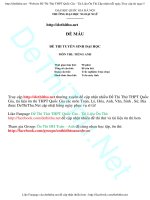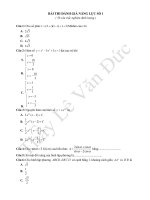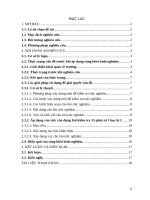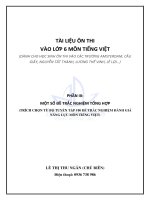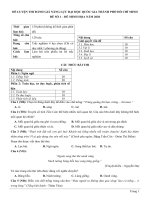Đề tiếng anh đánh giá năng lực số 3
Bạn đang xem bản rút gọn của tài liệu. Xem và tải ngay bản đầy đủ của tài liệu tại đây (231.41 KB, 7 trang )
ĐỀ THI THỬ TIẾNG ANH
KỲ THI THPT QUỐC GIA 2020
MÔN: TIẾNG ANH
Thời gian làm bài: 60 phút
ĐỀ SỐ 1
Mark the letter A, B, C, or D on your answer sheet to indicate the word whose underlined part differs
from the other three in pronunciation in each of the following questions.
Question 1:
A. mince
B. cipher
C. demand
D. cinema
Question 2:
A. cruiser
B. bruised
C. suit
D. disguise
Mark the letter A, B, C or D on your answer sheet to indicate the word that differs from the other three
in the position of primary stress in each of the following questions.
Question 3:
A. ambitious
B. investment
C. exhaust
D. constant
Question 4:
A. contestant
B. anchor
C. interview
D. satellite
Mark the letter A, B, C or D on your answer sheet to indicate the word(s) CLOSEST in meaning to the
underlined word in each of the following questions.
Question 5: She’s very strong-willed and if she's decided to drop out of school, nothing will stop her.
A. resolved
B. moronic
C. resigned
D. simple-minded
Question 6: Our teacher tends to skate over certain subjects which she finds difficult to talk about.
A. research
B. mislead
C. overlook
D. clarify
Mark the letter A, B, C or D on your answer sheet to indicate the word(s) OPPOSITE in meaning to
the underlined word in each of the following questions.
Question 7: The jury has to give an impartial verdict after listening to all of the evidence.
A. equitable
B. biased
C. unimportant
D. serious
Question 8: It’s freezing today, and you’re not going to wear a coat? Have you gone around the bend?
A. felt cold
B. been stable
C. been lunatic
D. become apathetic
Mark the letter A, B, C, or D on your answer sheet to indicate the most suitable response to complete
each of the following exchanges.
Question 9: Jack is talking to Adam after having not seen for months.
– Jack: “How’s tricks?” – Adam: “
”
A. I’m fine, thanks. And you?
B. The company is doing badly.
C. My son studies well, thanks!
D. We haven’t met for 9 months. It’s been a long time.
Question 10: Nadir is telling Kate about his scholarship.
Aland English: />
1
– Nadir: “I’ve been awarded a scholarship to study in America?”
– Kate: “Oh, really?
!”
A. Take care of yourself
B. Congratulations
C. You are always lucky
D. Lucky as you are
Mark the letter A, B, C or D on your answer sheet to indicate the correct answer to each of the following
questions.
Question 11: They’ve both had knee injuries, but the two friends make
B.
A. an
C. the
Question 12: I would feel less worried about Michael if he
A. had taken
B. takes
Question 13: Mei
light of their weaknesses.
D. a
more interest in his school work.
C. took
D. was taken
her money on the bus since she was forgetful.
A. has left
B. left
Question 14: She
C. is leaving
D. leaves
fainted when she heard her son had died.
A. rather than
B. nothing but
Question 15: The department store took
A. on
C. all but
D. near
more staff over the busy Christmas period.
B. away
C. off
D. in
Question 16: Determining the mineral content of soil samples is an exacting process,
experts
must perform detail tests to analyse soil specimens.
A. so that
B. however
Question 17: My dog as well as my cats
A. eat
A. get
D. therefore
C. have eaten
D. has eaten
twice a day.
B. eats
Question 18: It pays
C. afterwards
some professional advice before you make a decision.
B. getting
C. to getting
Question 19: The chemical injected into the body will attach itself
A. preferably
B. preferential
Question 20: I thought it was time to come
A. clean
D. preferring
with everybody about what I’d been doing.
B. pure
B. relevance
Question 22: Since the accident, Tom has walked with a
A. slope
to cancer cells.
C. preferentially
C. neat
Question 21: Sociological studies conducted within a Marxist frame of
A. reference
D. to get
B. limp
C. indication
D. straight
.
D. relation
.
C. lame
D. strain
Question 23: While Mr and Mrs Simpson were asleep, the burglar picked the lock of their front door
and crept
A. stealthily
into their living room.
B. lazily
Aland English: />
C. clumsily
D. criminally
2
Question 24: When his manager went on a business trip, Jack stepped into the
and chaired the
meeting.
A. hole
B. pool
C. breach
D. crack
Mark the letter A, B, C or D on your answer sheet to indicate the underlined part that needs correction
in each of the following questions.
Question 25: Different fourteen crops were grown 8,600 years ago by some of the world’s earliest
farmers.
A. Different fourteen
B. grown
C. some of
D. farmers
Question 26: Although there were a lot of opposition initially, many people now accept that infertile
couples have right to medical help.
A. were
B. a lot of opposition
C. now
D. medical help
Question 27: The meeting hasn’t started because of lack of chairs.
A. The
B. started
C. because of
D. lack
Reading the following passage and mark the letter A, B, C or D on your answer sheet to indicate the
correct word or phrase that best fits each of the numbered blanks.
Sylvia Earle, a (28)
botanist and one of the (29)
deep-sea explorers, has spent
over 6,000 hours, more than seven months, underwater. From her earliest years, Earle took her first
plunge into the open sea as a teenager. In the years since then she has taken part in a number of
landmark underwater projects, from exploratory expeditions around the world to her celebrated “Jim
dive” in 1978, which was the deepest solo dive (30)
made without cable connecting the diver
to a support vessel at the surface of the sea.
Clothed in a Jim suit, a futuristic suit of plastic and metal armor, which was secured (31)
a manned submarine, Sylvia Earle plunged vertically into the Pacific Ocean, at times at the speed of
100 feet per minute. On reaching the ocean floor, she was released from the submarine and from that
point her only connection to the sub was an 18-foot tether. For the next 2½ hours, Earle (32)
the seabed taking notes, collecting specimens, and planting a U.S. flag. Consumed by a desire to
descend deeper still, in 1981 she became involved in the design and manufacture of 20 deep-sea
submersibles, one of which took her to a depth of 3,000 feet. This did not end Sylvia Earle’s
accomplishments.
Question 28: A. marine
B. underwater
C. undersea
D. submarine
Question 29: A. furthest
B. foremost
C. greatest
D. utmost
Question 30: A. really
B. later
C. ever
D. mostly
Question 31: A. to
B. with
C. from
D. against
Aland English: />
3
Question 32: A. walked
B. roamed
C. dived
D. strolled
Read the following passage and mark the letter A, B, C or D on your answer sheet to indicate the
correct answer to each of the questions.
Since water is the basis of life, composing the greater part of the tissues of all living things, the
crucial problem of desert animals is to survive in a world where sources of flowing water are rare. And
since man’s inexorable necessity is to absorb large quantities of water at frequent intervals, he can
scarcely comprehend that many creatures of the desert pass their entire lives without a single drop.
Uncompromising as it is, the desert has not eliminated life but only those forms unable to
withstand its desiccating effects. No moist- skinned, water-loving animals can exist there. Few large
animals are found. The giants of the North American desert are the deer, the coyote, and the bobcat.
Since desert country is open, it holds more swift-footed running and leaping creatures than the tangled
forest. Its population is largely nocturnal, silent, filled with reticence, and ruled by stealth. Yet they are
not emaciate d. Having adapted to their austere environment, they are as healthy as animals anywhere
else in the word.
The secret of their adjustment lies in the combination of behaviour and physiology. None could
survive if, like mad dogs and Englishmen, they went out in the midday sun; many would die in a
matter of minutes. So most of them pass the burning hours asleep in cool, humid burrows underneath
the ground, emerging to hunt only by night. The surface of the sun-baked desert averages around 150
degrees, but 18 inches down the temperature is only 60 degrees.
Question 33: What is the topic of the passage?
A. Desert plants
B. Desert life
C. Animal life
D. Forest life
Question 34: The phrase “those forms” refers to all the following EXCEPT
A. water-loving animals
B. the bobcat
C. moist-skinned animals
D. many large animals
Question 35: The word “inexorable” in bold is closest in meaning to
A. relentless
B. indispensable
C. full
.
.
D. demanding
Question 36: The author states that one characteristic of animals living in the desert is that they
.
A. are smaller and fleeter than forest animals
B. are less healthy than animals living in different places
C. can hunt in temperature of 150 degrees
D. live in an accommodating environment
Question 37: Which of the following generalizations is supported by the passage?
A. Water is the basis of life.
Aland English: />
4
B. All living things adjust to their environments.
C. Desert life is colourful.
D. Healthy animals live longer lives.
Read the following passage and mark the letter A, B, C or D on your answer sheet to indicate the
correct answer to each of the questions.
Sigmund Freud was not a literary theorist. However, he did contribute to critical theory through
both his theories and his use of art to show that the application of psychology can extend to the highest
forms of cultures. Freud was always interested in literature, and he drew some of the best illustrations
of his theories from classic poems and plays.
Freud saw the unconscious as the impetus of both cultural and psychic activity. Therefore, the
same principles operated in both, and that the same mechanisms – such as displacement and
symbolization – applied. While Freud was not the first to note the importance of the unconscious mind,
he was the first to attempt a coherent theory of its operation and function. He argued that the
unconscious operates according to universal law, and is crucial to all aspects of mental life that involve
fantasy, or diversion from reality. From this point of view, it is natural to apply Freudian principles to
imaginative literature. Writers transform individual, unconscious fantasy into universal art – a kind of
formal fantasy halfway between a reality that denies wishes and a world of imagination in which every
wish is granted.
In focusing on the unconscious origins for literature, Freud was in a sense reviving the traditional
idea of divine inspiration. Philosophers and art theorists have often turned to such a theory of the
imagination to explain multiple meanings, repetition, and any apparent disorder in art. Similarly,
psychoanalysis uses the theory of the unconscious to explain examples of “disorder’ in consciousness,
such as dreams.
This analogy allowed Freud to suggest that fantasies called art could be interpreted in the same
way as dreams. Writers, as Freud noted, have always seen great significance in dreams. In his view,
portrayals of dreams in works of literature supported his own theories about their structures,
mechanisms, and interpretation. For example, the mechanisms of displacement and symbolization
obviously resemble the literary devices of metaphor and symbolism.
Critics of Freud have objected that the non-logical processes of the unconscious do not resemble
the conscious effort that results in work of literature. Freud would reply that while conscious thought
is necessary to produce works of art, the creative sources of art remain in the conscious. In this view,
conscious activity merely obscures what is truly important in art. What interested Freud were the deep
unconscious structures literature shares with myth and religion, as well as with dreams. The apparent
individuality of literature was not as significant as its ultimate universality.
Aland English: />
5
Question 38: Which of the following best summarizes the passage?
A. The best way to understand the creation of literature is through Freud’s theory of
psychoanalysis.
B. Freud argued convincingly that both psychic phenomena and literature can be interpreted with
reference to the unconscious.
C. Creating works of literature is very similar to dreaming.
D. Freud’s theories explain why both dreams and literature contain various forms of disorder.
Question 39: According to the passage, which of the following is true of Freud?
A. He was a literary theorist.
B. He has had an influence on literary history.
C. He wrote several plays and poems that illustrate his theories.
D. He was the first to discover the unconscious.
Question 40: The word “both” in paragraph 2 refers to
.
A. displacement and symbolization
B. repression and the economy of psychic expenditure
C. cultural and psychic phenomena
D. principles and mechanisms
Question 41: The author uses the phrase “formal fantasy” in paragraph 2 in order to
.
A. describe the nature of literature
B. describe the nature of the unconscious
C. give an example of diversion from reality
D. give an example of a Freudian principle
Question 42: According to the passage, displacement in dreams is similar to
A. symbolization
B. metaphor
C. symbolism
.
D. repression
Question 43: What possible objection to the passage’s main idea does the author discuss in the last
paragraph?
A. Freud emphasized the unconscious, but writing results from conscious thought.
B. Freud claimed that art is created logically, but it really has unconscious origins.
C. Writers have never placed much significance on dreams.
D. Freud argued that literature is individual, but it is actually universal.
Question 44: The word “their” in paragraph 4 refers to
A. writers
B. works
.
C. theories
D. dreams
Question 45: Why does the author mention “multiple meaning” and “repetition” in paragraph 3?
A. To emphasize the non-rational nature of art.
B. To give examples of “disorder” in art.
C. To show the similarity between art and dreams.
Aland English: />
6
D. To give examples of divine inspiration.
Mark the letter A, B, C or D on your answer sheet to indicate the sentence that is closet in meaning to
each of the following question.
Question 46: “You should have finished the report by now” John told his secretary.
A. John reproached his secretary for not having finished the report.
B. John said that his secretary had not finished the report.
C. John reminded his secretary of finishing the report on time.
D. John scolded his secretary for not having finished the report
Question 47: They got success since they took my advice.
A. They took my advice, and failed.
B. If they did not take my advice, they would not get success.
C. But for taking my advice, they would not have got success.
D. My advice stopped them from getting success.
Question 48: I am very interested in the book you lent me last week.
A. The book is interesting enough for you to lend me last week.
B. It was the interesting book which you lent me last week.
C. The book which you lent me last week is too interesting to read.
D. The book that you lent me last week interests me a lot.
Mark the letter A, B, C or D on your answer sheet to indicate the sentence that best combines each pair
of sentences in the following question.
Question 49: This house was built years ago. It is still in very good shape.
A. This house, which built years ago, is still in very good shape.
B. This house, built years ago, is still in very good shape.
C. This house, building years ago, is still in very good shape.
D. This house, which was built years ago is still in very good shape.
Question 50: John doesn’t play tennis. Neither does David.
A. John nor David doesn’t play tennis.
B. Neither John nor David play tennis.
C. Neither John nor David plays tennis.
D. Either John or David plays tennis.
-------------- The end --------------
Aland English: />
7
